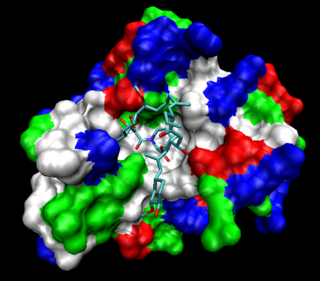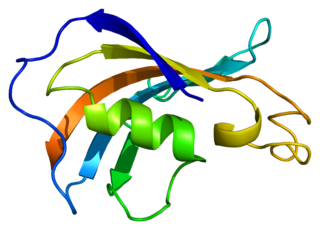Related Research Articles

DNA-binding proteins are proteins that have DNA-binding domains and thus have a specific or general affinity for single- or double-stranded DNA. Sequence-specific DNA-binding proteins generally interact with the major groove of B-DNA, because it exposes more functional groups that identify a base pair. However, there are some known minor groove DNA-binding ligands such as netropsin, distamycin, Hoechst 33258, pentamidine, DAPI and others.

The mammalian target of rapamycin (mTOR), also referred to as the mechanistic target of rapamycin, and sometimes called FK506-binding protein 12-rapamycin-associated protein 1 (FRAP1), is a kinase that in humans is encoded by the MTOR gene. mTOR is a member of the phosphatidylinositol 3-kinase-related kinase family of protein kinases.
Stuart L. Schreiber is a scientist at Harvard University and co-Founder of the Broad Institute. He has been active in chemical biology, especially the use of small molecules as probes of biology and medicine. Small molecules are the molecules of life most associated with dynamic information flow; these work in concert with the macromolecules that are the basis for inherited information flow.
In molecular biology, immunophilins are endogenous cytosolic peptidyl-prolyl isomerases (PPI) that catalyze the interconversion between the cis and trans isomers of peptide bonds containing the amino acid proline (Pro). They are chaperone molecules that generally assist in the proper folding of diverse "client" proteins. Immunophilins are traditionally classified into two families that differ in sequence and biochemical characteristics. These two families are: "cyclosporin-binding cyclophilins (CyPs)" and "FK506-binding proteins (FKBPs)". In 2005, a group of dual-family immunophilins (DFI) has been discovered, mostly in unicellular organisms; these DFIs are natural chimera of CyP and FKBPs, fused in either order.

The FKBPs, or FK506 binding proteins, constitute a family of proteins that have prolyl isomerase activity and are related to the cyclophilins in function, though not in amino acid sequence. FKBPs have been identified in many eukaryotes, ranging from yeast to humans, and function as protein folding chaperones for proteins containing proline residues. Along with cyclophilin, FKBPs belong to the immunophilin family.

FK506-binding protein 4 is a protein that in humans is encoded by the FKBP4 gene.
Sex pheromones are pheromones released by an organism to attract an individual of the same species, encourage them to mate with them, or perform some other function closely related with sexual reproduction. Sex pheromones specifically focus on indicating females for breeding, attracting the opposite sex, and conveying information on species, age, sex and genotype. Non-volatile pheromones, or cuticular contact pheromones, are more closely related to social insects as they are usually detected by direct contact with chemoreceptors on the antennae or feet of insects.

Peptidyl-prolyl cis-trans isomerase FKBP1A is an enzyme that in humans is encoded by the FKBP1A gene. It is also commonly referred to as FKBP-12 or FKBP12 and is a member of a family of FK506-binding proteins (FKBPs).

FK506 binding protein 5, also known as FKBP5, is a protein which in humans is encoded by the FKBP5 gene.

Peptidyl-prolyl cis-trans isomerase FKBP1B is an enzyme that in humans is encoded by the FKBP1B gene.

FK506-binding protein 3 also known as FKBP25 is a protein that in humans is encoded by the FKBP3 gene.

Glomulin is a protein that in humans is encoded by the GLMN gene.

FK506-binding protein 2 is a protein that in humans is encoded by the FKBP2 gene.

FK506-binding protein 10 is a protein that in humans is encoded by the FKBP10 gene.

FK506 binding protein 6, also known as FKBP6, is a human gene. The encoded protein shows structural homology to FKBP immunophilins, which bind to the immunosuppressants FK506 and rapamycin.

Netropsin is a polyamide with antibiotic and antiviral activity. Netropsin was discovered by Finlay et al., and first isolated from the actinobacterium Streptomyces netropsis. It belongs to the class of pyrrole-amidine antibiotics.

mTOR inhibitors are a class of drugs that inhibit the mechanistic target of rapamycin (mTOR), which is a serine/threonine-specific protein kinase that belongs to the family of phosphatidylinositol-3 kinase (PI3K) related kinases (PIKKs). mTOR regulates cellular metabolism, growth, and proliferation by forming and signaling through two protein complexes, mTORC1 and mTORC2. The most established mTOR inhibitors are so-called rapalogs, which have shown tumor responses in clinical trials against various tumor types.
Gerald R. Crabtree is the David Korn Professor at Stanford University and an Investigator in the Howard Hughes Medical Institute. He is known for defining the Ca2+-calcineurin-NFAT signaling pathway, pioneering the development of synthetic ligands for regulation of biologic processes and discovering chromatin regulatory mechanisms involved in cancer and brain development. He is a founder of Ariad Pharmaceuticals, Amplyx Pharmaceuticals, and Foghorn Therapeutics.

FK1012 is a dimer consisting of two molecules of FK506 (tacrolimus) linked via their vinyl groups. It is used as a research tool in chemically induced dimerization applications. FK506 binding proteins (FKBPs) do not normally form dimers but can be caused to dimerize in the presence of FK1012. Genetically engineered proteins based on FKBPs can be used to manipulate protein localization, signalling pathways and protein activation.
David Nathan Beratan is an American chemist and physicist, the R.J. Reynolds Professor of Chemistry at Duke University. He has secondary appointments in the departments of Physics and Biochemistry. He is the Director of the Center for Synthesizing Quantum Coherence, a NSF Phase I Center for Chemical Innovation.
References
- ↑ "BCMP | Department of Biological Chemistry & Molecular Pharmacology". Bcmp.med.harvard.edu. Retrieved 2013-09-28.
- ↑ "Jon Clardy | Clardy Laboratory". Clardy.med.harvard.edu. Retrieved 2013-09-28.
- ↑ Berry, R. S., Clardy, J. & Schafer, M. E. Benzyne. J. Am. Chem. Soc. 86, 2738–2739 (1964)
- ↑ "The Chemical Biologists | Harvard Magazine Mar-Apr 2005". Harvardmagazine.com. Retrieved 2013-09-28.
- ↑ The American Society of Pharmacognosy Newsletter. 1-3 (2004)
- ↑ Pettit, G. R. et al. Isolation and structure of bryostatin 1. J. Am. Chem. Soc. 104, 6846–6848 (1982)
- ↑ Lindquist, N., Fenical, W., Van Duyne, G. D. & Clardy, J. Isolation and structure determination of diazonamides A and B, unusual cytotoxic metabolites from the marine ascidian Diazona chinensis. J. Am. Chem. Soc. 113, 2303–2304 (1991)
- ↑ Schantz, E. J. et al. Structure of saxitoxin. J. Am. Chem. Soc. 97, 1238–1239 (1975)
- ↑ Lin, Y.-Y. et al. Isolation and structure of brevetoxin B from the' red tide' dinoflagellate Ptychodiscus brevis (Gymnodinium breve). J. Am. Chem. Soc. 103, 6773–6775 (1981)
- ↑ "Of beetles and bacteria | The Scientist Magazine". Archived from the original on 2013-10-02. Retrieved 2014-08-25.
- ↑ Oh, D.-C., Poulsen, M., Currie, C. R. & Clardy, J. Dentigerumycin: a bacterial mediator of an ant-fungus symbiosis. Nat Chem Biol 5, 391–393 (2009)
- ↑ Willson, E. & Yarnell, A. In Cahoots: Fungi, Ants, And Bacteria. Chemical & Engineering News 87, 15 (2009)
- ↑ Scott, J. J. et al. Bacterial protection of beetle-fungus mutualism. Science 322, 63 (2008)
- ↑ Drahl, C. Beetle Bacteria Wield An Antifungal Agent. Chemical & Engineering News 86, 47 (2008)
- ↑ "Jon Clardy". Academy.asm.org. Archived from the original on 2013-04-25. Retrieved 2013-09-28.
- ↑ Van Duyne, G.D., Standaert, R. F., Karplus, P. A., Schreiber. S.L., Clardy J. Atomic structure of FKBP-FK506, an immunophilin-immunosuppressant complex. Science 252, 839-842 (1991)
- ↑ Choi, J., Chen, J., Schreiber S. L., Clardy J. Structure of the FKBP12-rapamycin complex interacting with the binding domain of human FRAP. Science 273, 239-242 (1996)
- ↑ Billion Dollar Molecule: The Quest for the Perfect Drug, Barry Werth, 1994
- ↑ Sandler, B. H., Nikonova, L., Leal, W. S. & Clardy, J. Sexual attraction in the silkworm moth: structure of the pheromone-binding-protein-bombykol complex. Chemistry & Biology 7, 143–151 (2000)
- ↑ Sandler, B. H., Nikonova, L., Leal, W. S. & Clardy, J. Sexual attraction in the silkworm moth: structure of the pheromone-binding-protein–bombykol complex. Chemistry & Biology 7, 143–151 (2000)
- ↑ Brady, S. F., Chao, C. J. & Clardy, J. New Natural Product Families from an Environmental DNA (eDNA) Gene Cluster. J. Am. Chem. Soc. 124, 9968–9969 (2002)
- ↑ Brady, S. F., Chao, C. J. & Clardy, J. Long-chain N-acyltyrosine syntheses from environmental DNA. Appl. Environ. Microbiol. 70, 6865–6870 (2004)